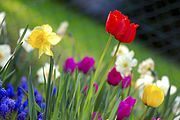Saturday, December 15, 2007
| This article needs additional citations for verification. Please help improve this article by adding reliable references. Unsourced material may be challenged and removed. (June 2007) |
A garden is a planned space, usually outdoors, set aside for the display, cultivation, and enjoyment of plants and other forms of nature. The garden can incorporate both natural and man-made materials. The most common form is known as a residential garden. Western gardens are almost universally based around plants. Zoos, which display wild animals in simulated natural habitats, were formerly called zoological gardens. Some traditional types of eastern gardens, such as Zen gardens, use plants sparsely or not at all. Xeriscape gardens use local native plants that do not require irrigation or extensive suse of other resources while still providing the benefits of a garden environment. Gardens may exhibit structural enhancements, sometimes called garden follies, including water features such as fountains, ponds (with or without fish), waterfalls or creeks, dry creek beds, statuary, arbors, trellaces and more.
Some gardens are for ornamental purposes only, while some gardens also produce food crops, sometimes in separate areas, or sometimes intermixed with the ornamental plants. Food-producing gardens are distinguished from farms by their smaller scale, more labor-intensive methods, and their purpose (enjoyment of a hobby rather than produce for sale).
Gardening is the activity of growing and maintaining the garden. This work is done by an amateur or professional gardener. A gardener might also work in a non-garden setting, such as a park, a roadside embankment, or other public space. Landscape architecture is a related professional activity with landscape architects tending to specialise in design for public and corporate clients.
The term "garden" in British English refers to an enclosed area of land, usually adjoining a building.[1] This would be referred to as a yard in American English.
Contents[hide] |
[edit] Garden design
Garden design is the creation of plans for layout and planting of gardens and landscapes. Garden design may be done by the garden owner themselves, or by professionals. Most professional garden designers are trained in principles of design and in horticulture, and have an expert knowledge and experience of using plants. Some professional garden designers are also landscape architects, a more formal level of training that usually requires an advanced degree and often a state license. Many amateur gardeners also attain a high level of experience from extensive hours working in their own gardens, through casual study or master gardener programs.
Elements of garden design include the layout of hard landscape, such as paths, walls, water features, sitting areas and decking, as well as the plants themselves, with consideration for their horticultural requirements, their season-to-season appearance, lifespan, growth habit, size, speed of growth, and combinations with other plants and landscape features. Consideration is also given to the maintenance needs of the garden, including the time or funds available for regular maintenance, which can affect the choices of plants regarding speed of growth, spreading or self-seeding of the plants, whether annual or perennial, and bloom-time, and many other characteristics.
The most important consideration in garden design is how the garden will be used, followed closely by the desired stylistic genres, and the way the garden space will connect to the home or other structures in the surrounding areas. All of these considerations are subject to the limitations of the budget. Budget limitations can be addressed by a simpler garden style with fewer plants and less costly hardscape materials, seeds rather than sod for lawns, and plants that grow quickly; alternately, garden owners may choose to create their garden over time, area by area.
[edit] Elements of a garden
| Part of a series on Horticulture and Gardening |
 |
| Gardening |
|---|
| Gardening • Garden • Botanical garden • Arboretum • Botany • Plant |
| Horticulture |
| Horticulture • Agriculture • Urban agriculture • City farm • Organic farming • Herb farm • Hobby farm • Intercropping • Farm |
| Customs |
| Plant protection |
The elements of a garden consist of the following:
Natural conditions and materials:
Man-made elements:
- Terrace, patio, deck
- Paths
- Lighting
- Raised beds
- Outdoor art/sculpture, such as Gazebos
- Pool, water garden, or other water elements
[edit] Uses for the garden space
A garden can have aesthetic, functional, and recreational uses:
- Cooperation with nature
- Observance of nature
- Relaxation
- Growing useful produce
- Flowers to cut and bring inside for indoor beauty
- Fresh herbs and vegetables for cooking
Subscribe to Posts [Atom]

